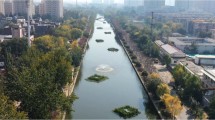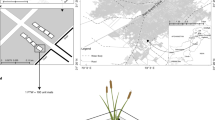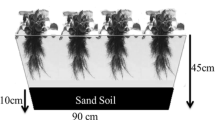Abstract
The treatment efficiencies of floating treatment wetlands (FTWs) containing two types of macrophytes, Typha angustifolia and Canna iridiflora, were investigated in a pilot scale study in the tropical climate of Sri Lanka. In batch experiments, over 80 % of biological oxygen demand (BOD5) and ammonium (NH +4 -N) removal was observed, while nitrate (NO −3 -N) removal was over 40 %. Typha angustifolia showed slightly higher BOD5, NH +4 -N and NO −3 -N removal than Canna iridiflora. Because of higher and steady root growth, Typha angustifolia resulted in a better performance and has a greater potential to extract nutrients from wastewater and allow water-plant interactions than Canna iridiflora whose root mat is thick and compact. Similar to the batch system, the continuous flow systems performed better at most times with Typha angustifolia. FTWs with Typha angustifolia may be considered a possible solution for lake restoration where there are space and cost constraints.




Similar content being viewed by others
References
Allen WC, Hook PB, Biederman JA, Stein OR (2002) Temperature and wetland plant species effects on wastewater treatment and root zone oxidation. Journal of Environmental Quality 31:1010–1016
Armstrong J, Armstrong W (1988) Phragmites australis – a preliminary study of soil oxidizing sites and internal gas transport pathway. New Phytol 108:373–382
Ash R, Troung P (2003) The use of Vetiver grass wetlands for sewerage treatment in Australia. Proceedings of 3rd International Conference on Vetiver, Guangzhou, China, 132-141
Brix H (1994) Functions of macropytes in constructed wetlands. Water Science and Technology 29(4):71–78
Burgess ND, Hirons GJM (1992) Creation and management of artificial nesting sites for wetland birds. Journal of Environmental Management 34(4):285–295
Caselles-Osorio A, García J (2007) Impact of different feeding strategies and plant presence on the performance of shallow horizontal subsurface-flow constructed wetlands. Science of the Total Environment 378:253–262
Dendene MA, Rolland T, Tremolieres M, Cariener R (1993) Effect of ammonium ions on the net photosynthesis of three species of Eldoea. Aquatic Botany 46(3–4):301–315
Eaton AD, Clesceri SL, Greenberg EA (1995) Standard Methods for the Examination of Water and Wastewater. American Public Health Association, Washington
Fonder N, Headley T (2010) Systematic nomenclature and reporting for treatment wetlands. In: Vymazal J (ed) Water and Nutrient Management in Natural and Constructed Wetlands. Springer, Dordrecht, pp 191–220
Garbutt P (2004) An investigation into the application of floating reed bed and barley straw techniques for the remediation of eutrophic waters. Water Environment Journal 19(3):174–180
Greenway M (2003) Suitability of macrophytes for nutrient removal from surface flow constructed wetlands receiving secondary treated effluent in Queensland, Australia. Water Science and Technology 48(2):121–128
Guimarães JRD, Meili M, Hylander LD, Silva EDC, Roulet M, Mauro JBN, Lemos RA (2000) Mercury net methylationin five tropical flood plain regions of Brazil: high in the root zone of floating macrophyte mats but low in surface sediments and flooded soils. The Science of the Total Environment 261:99–107
Hubbard RK, Gascho GJ, Newton GL (2004) Use of floating vegetation to remove nutrients from swine lagoon wastewater. Transactions of ASAE 47(6):1963–1972
Jinadasa KBSN, Tanaka N, Sasikala S, Werellagama DRIB, Mowjood MIM, Ng WJ (2008) Impact of harvesting on constructed wetlands performance – a comparison between Scirpus grossus and Typha angustifolia. Journal of Environmental Science and Health Part A 43(6):664–671
Johansson L (1997) Use of light expanded clay aggregates (Leca) for removal of phosphorus from wastewater. Water Science and Technology 35(5):1–10
Juwarkar A, Oke B, Juwarkar A, Patnaik SM (1995) Domestic wastewater treatment through constructed wetland in India. Water Science and Technology 32(3):291–294
Kansiime F, van Bruggen JJA (2001) Distribution and retention of faecal coliforms in the Nakivubo wetland in Kampala, Uganda. Water Science and Technology 44(11/12):199–206
Kato Y, Takemon Y, Hori M (2009) Invertebrate assemblages in relation to habitat type on a floating mat in Mizorogaike Pond, Kyoto, Japan. Limnology 10:167–176
Konnerup D, Koottatep T, Brix H (2009) Treatment of domestic wastewater in tropical, subsurface flow constructed wetlands planted with Canna and Heliconia. Ecological Engineering 35:248–257
Koottatep T, Polprasert C (1997) Role of plant uptake on nitrogen removal in constructed wetlands located in tropics. Water Science and Technology 36(12):1–8
Kyambadde J, Kansiime F, Gumaelius L, Dalhammar G (2004) A comparative study of Cyperus papyrus and Miscanthidium violaceum-based constructed wetlands for wastewater treatment in a tropical climate. Water Research 38(2):475–485
Lin Y, Jing S, Wang T, Lee D (2002) Effects of macrophytes and external carbon sources on nitrate removal from ground water in constructed wetlands. Environmental Pollution 119(3):413–420
Reddy KR, D’Angelo EM (1997) Biogeochemical indicators to evaluate pollutant efficiency in constructed wetlands. Water Science and Technology 35(5):1–10
Sooknah RD, Wilkie AC (2004) Nutrient removal by floating aquatic macrophytes cultured in anaerobically digested flushed dairy manure wastewater. Ecological Engineering 22:27–42
Systat Software (2004) Inc. SigmaStat 3.1for Windows. San Jose, CA 95110, USA
Tanner CC, Clayton JS, Upsdell MP (1995) Effect of loading rate and planting on treatment of dairy farm wastewaters in constructed wetlands – II. Removal of nitrogen and phosphorus. Water Research 29(1):27–34
Tanner CC, Headley TR (2011) Components of floating emergent macrophyte treatment wetlands influencing removal of stormwater pollutants. Ecological Engineering 37:474–486
Tsujino R, Fujita N, Katayama M, Kawase D, Matsui K, Seo A, Shimamura T, Takemon Y, Tsujimura N, Yumoto T, Ushimaru A (2010) Restoration of floating mat bog vegetation after eutrophication damages by improving water quality in a small pond. Limnology 11:289–297
Van de Moortel AMK, Meers E, Pauw ND, Tack FMG (2010) Effects of vegetation, season and temperature on the removal of pollutants in experimental floating treatment wetlands. Water, Air, and Soil Pollution 212:181–297
Vymazal J (2002) The use of subsurface constructed wetlands for wastewater treatment in the Czech Republic: 10 years experience. Ecological Engineering 18:633–646
Vymazal J (2007) Removal of nutrients in various types of constructed wetlands. Science of the Total Environment 380(1–3):48–65
Zhang DQ, Tan SK, Gersberg RM, Zhu JF, Sadreddini S, Li YF (2011) Nutrient removal in tropical subsurface flow constructed wetlands under batch and continuous flow conditions. Journal of Environmental Management 96:1–6
Acknowledgments
The authors would like to express their gratitude towards Environmental Endeavor-2, a collaboration effort between the LIEN Foundation and Nanyang Technological University, for financially supporting this project. Kind technical assistance from Mr. P Fernando, National Water Supply and Drainage Board is greatly appreciated.
Author information
Authors and Affiliations
Corresponding author
Electronic supplementary material
Below is the link to the electronic supplementary material.
ESM 1
(PDF 301 kb)
Rights and permissions
About this article
Cite this article
Weragoda, S.K., Jinadasa, K.B.S.N., Zhang, D.Q. et al. Tropical Application of Floating Treatment Wetlands. Wetlands 32, 955–961 (2012). https://doi.org/10.1007/s13157-012-0333-5
Received:
Accepted:
Published:
Issue Date:
DOI: https://doi.org/10.1007/s13157-012-0333-5




